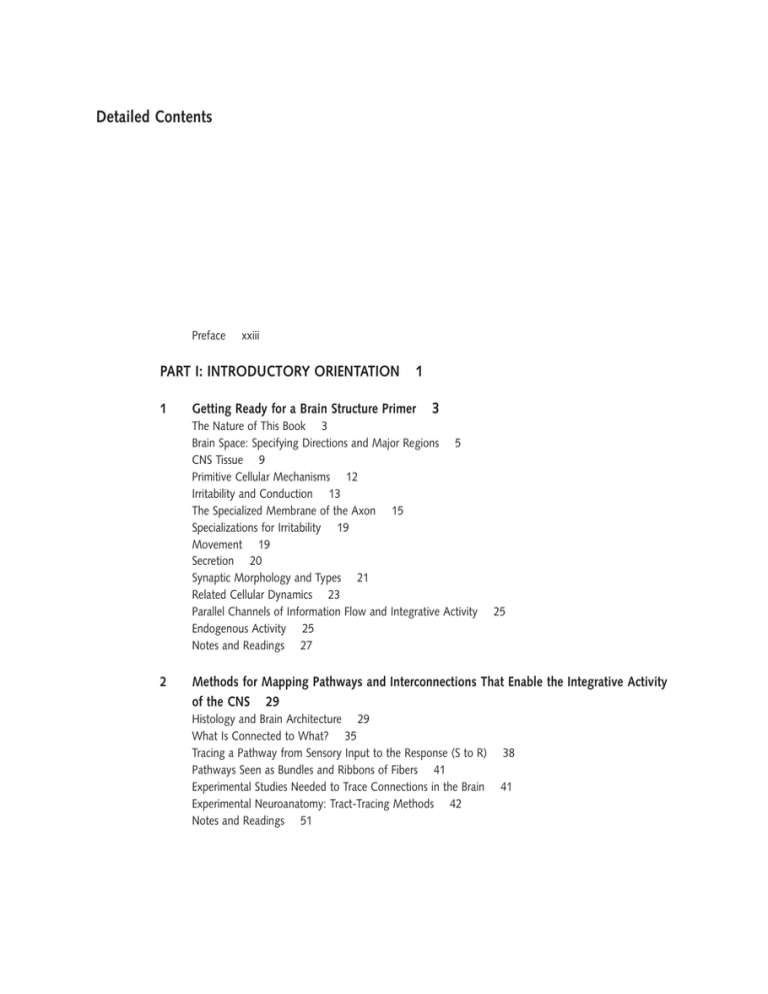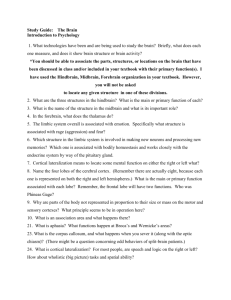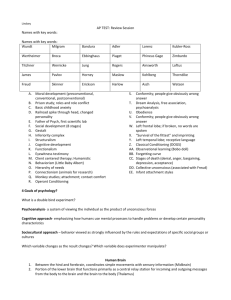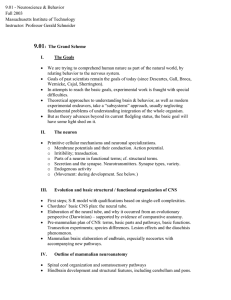Detailed Contents
advertisement

Detailed Contents Preface xxiii PART I: INTRODUCTORY ORIENTATION 1 1 Getting Ready for a Brain Structure Primer 3 The Nature of This Book 3 Brain Space: Specifying Directions and Major Regions 5 CNS Tissue 9 Primitive Cellular Mechanisms 12 Irritability and Conduction 13 The Specialized Membrane of the Axon 15 Specializations for Irritability 19 Movement 19 Secretion 20 Synaptic Morphology and Types 21 Related Cellular Dynamics 23 Parallel Channels of Information Flow and Integrative Activity 25 Endogenous Activity 25 Notes and Readings 27 2 Methods for Mapping Pathways and Interconnections That Enable the Integrative Activity of the CNS 29 Histology and Brain Architecture 29 What Is Connected to What? 35 Tracing a Pathway from Sensory Input to the Response (S to R) 38 Pathways Seen as Bundles and Ribbons of Fibers 41 Experimental Studies Needed to Trace Connections in the Brain 41 Experimental Neuroanatomy: Tract-Tracing Methods 42 Notes and Readings 51 xii Detailed Contents PART II: THE CENTRAL NERVOUS SYSTEM, FROM INITIAL STEPS TO ADVANCED CHORDATES 53 3 Evolution of Multicellular Organisms with Neuron-Based Coordination 55 Basic Survival Skills 55 The First Neurons and Nerve Networks 56 The Nervous System in Basic Concept 58 Some Terminology for Brain Talk 59 Introducing the Simplest Chordates 60 Natural Selection and the Logic of Evolution 63 The Behavioral Demands That Changed the Neural Tube 63 Notes and Readings 65 4 Expansions of the Neuronal Apparatus of Success 67 Why We Can Talk about Broad Aspects of Brain Evolution with Some Confidence 67 Three Enlargements Formed the Primitive Brain 67 Expansions of the Hindbrain 69 Early Forebrain Expansion Served Olfactory Functions 72 Midbrain Expansions, Distance Receptors, and Decussations 75 A Second Expansion of the Forebrain with Invasion of Non-olfactory Inputs 77 Concurrent Evolutionary Changes: Motor Control and Plasticity 79 Concurrent Evolutionary Changes: Motivational States 80 A Third Expansion of the Forebrain: Anticipating Events and Planning Actions 81 Brain Sizes Relative to Body Weight Compared for Present-Day Animals 81 Where We Stand in the Path to Our Goal 83 Notes and Readings 84 PART III: INTRODUCTION TO CONNECTION PATTERNS AND SPECIALIZATIONS IN THE EVOLVING CNS 87 5 The Ancestors of Mammals: Sketch of a Pre-mammalian Brain 89 The “Old Chassis” for the Building of Further Additions 90 Subdividing the CNS 94 The Basic Setup: Major Types of Neurons 96 Sensory Channels of Conduction: Local Reflex, and Not so Local 97 Old Ribbons to the Brain 101 Ribbons to the Little Brain: The Cerebellum 103 Notes and Readings 106 6 Some Specializations Involving Head Receptors and Brain Expansions 107 Electroreception and the Cerebellum 107 Infrared Sensors in Pit Vipers 109 Echolocation and the Auditory System 110 The Visual Systems of Primates 111 Whisker Fields and Barrel Fields 111 Other Behavioral Specializations with Corresponding Enlargements of Brain Parts 112 Notes and Readings 116 xiii Detailed Contents 7 The Components of the Forebrain Including the Specialty of the Mammals: The Neocortex 117 Forebrain Removal Experiments 117 Cat Behavior after Forebrain Removal 117 Rat Behavior Is Less Drastically Affected by Forebrain Removal 118 Pigeons after Forebrain Removal, Sparing the Optic Tracts 119 Forebrain Function: A Conclusion 120 The Problem of Species Differences in Brain Lesion Effects 120 The Phenomena of Diaschisis: An Answer to the Problem 120 What Can We Conclude about Interpreting Effects of Brain Lesions? 123 Role of the Corpus Striatum 123 The Rostral End of the Brainstem Located between the Hemispheres (’Tweenbrain) 124 Limbic System of the Forebrain 125 Olfactory System Origins of Major Functions of the Limbic Endbrain 126 Overview of the Roles of Corpus Striatum and Limbic Forebrain 128 Neocortex, the Grand Innovation of the Mammals: Appearance of New Pathways 128 But What Does It Do? Why Did Neocortex Evolve? 134 Taking Stock 134 Notes and Readings 135 PART IV: DEVELOPMENT AND DIFFERENTIATION: SPINAL LEVEL 137 8 The Neural Tube Forms in the Embryo, and CNS Development Begins 139 Before There Is Any CNS 139 The Onset of a Nervous System 140 Molecules from the Notochord Induce the Formation of the Nervous System 141 The Neural Crest Gives Rise to the PNS 142 Cell Proliferation in the Early Neural Tube 143 Diversity in Neuronal Migration 145 Differentiation of the Neurons Begins 149 Notes and Readings 150 9 The Lower Levels of Background Support: Spinal Cord and the Innervation of the Viscera 153 Major Features of Cord Structure 153 Questions from Comparing Different Species 156 The Local Reflex Channel and the Older Lemniscal Channels 158 The Mammalian Highway for Ascending Somatosensory Information 161 Cerebellar Channel 162 The Pathways of Regulation within the Spinal Cord Itself 163 The Pathways of Influence and Control from the Brain 164 A Reminder 165 Maintaining Stability of the Internal Environment: The Autonomic Nervous System 166 Three Major Divisions of the Motor System 166 A Sketch of the Autonomic Nervous System 167 Chemical Mediation at Autonomic Nervous System Synapses 171 xiv Detailed Contents The Enteric Nervous System 171 Levels of Control of the Internal Environment 173 Notes and Readings 173 Intermission: The Ventricular System, the Meninges, and the Glial Cells 175 Notes and Readings 178 PART V: DIFFERENTIATION OF THE BRAIN VESICLES 179 10 Hindbrain Organization, Specializations, and Distortions 181 A Glamorized Spinal Cord 81 Vital Functions of the Hindbrain 183 Routine Maintenance Services 184 Hindbrain Participation in Mammalian Higher Functions 184 The Isodendritic Core of the Brainstem 185 Segmentation of the Hindbrain 186 Columns and Cranial Nerves 188 The Adult Hindbrain: Cell Groups and Axons of Passage 192 Somatosensory Inputs from the Face 193 The Evolution of Crossed Projections 194 Hindbrain Sensory Channels in Mammals 197 Hindbrain Specializations and Mosaic Evolution 199 Notes and Readings 204 11 Why a Midbrain? Notes on Evolution, Structure, and Functions 205 Primitive Vision 206 Primitive Olfaction 206 A Structural Consequence of the Priority of Escape Behavior for Survival 207 The Midbrain Correlation Centers 208 Outputs of Midbrain for Motor Control 210 Mosaic Evolution of Midbrain 212 Long Axons Passing through the Midbrain 212 Notes and Readings 216 12 Picturing the Forebrain with a Focus on Mammals 217 Pictures of Ancestral and Modern Endbrain 218 Words for Forebrain Parts 220 Major Structural and Functional Subdivisions of the ’Tweenbrain 220 Major Parts of the Telencephalon 222 Origins and Course of Two Major Pathways of the Forebrain 222 The Neocortex Is Involved in Both Major Systems 224 Interim Review of Neuroanatomy 226 Segmentation of the Forebrain 227 Notes on Neocortical Origins 227 Notes and Readings 232 xv Detailed Contents 13 Growth of the Great Networks of Nervous Systems 235 The Axonal Growth Cone 235 Signals That Shape the Development of Neuronal Circuits 239 Four Types of Chemical Guidance 244 Two Modes of Axon Growth 247 Formation of Maps in the Brain 247 Plasticity in Brain Maps 249 More Plasticity in the CNS: Collateral Sprouting 252 Modulation of Competitive Axonal Growth Vigor 255 Rules of Sprouting Apply to Development, with Implications for Evolutionary Change 256 Plasticity in the Small Interneurons of the Adult Brain 256 Structural Regression during Development and Its Purposes 257 Axon Loss in the Damaged CNS: Is Regeneration Possible? 258 Notes and Readings 259 PART VI: A BRIEF STUDY OF MOTOR SYSTEMS 263 14 Overview of Motor System Structure 265 A Functional Starting Point for the Study: Three Major Types of Movement Critical for Survival 265 Midbrain Control of the Three Types of General-Purpose Movement 266 The Midbrain Was the Connecting Link between the Primitive Forebrain and Motor Systems 267 Head Receptors and Locomotor Approach and Avoidance 268 Initiation of Foraging by Activity Intrinsic to the Brain 268 The Motor System Hierarchy 269 Locomotor Pattern Generation and Its Adjustments by Vestibular and Cerebellar Systems 269 Orienting of Head and Body 272 Grasping: The Third Major Type of Movement Controlled by the Midbrain 275 Comparative Anatomy of the Red Nucleus and Its Projection to the Spinal Cord 275 A Structural Approach to Understanding Motor Control: Begin with the Motor Neurons 277 The Spatial Arrangements of Somatic Motor Neurons in the Spinal Cord 278 Notes and Readings 281 15 Descending Pathways and Evolution 283 Axons Descending from Brain to Spinal Cord: Functional Groupings 283 Functions of the Descending Pathways: The Corticospinal Tract 286 Functions of the Descending Pathways: The Medial Hindbrain Tracks 287 Functions of the Descending Pathways: The Lateral Brainstem Tracks 287 A Conclusion with Application to Humans 289 The Brain Disconnected from the Motor Pattern Generators 289 Importance of the Corticospinal Tract for Innate and Learned Movements That Require Special Dexterity 290 The Nature of the Spinal Motor Pattern Generators 291 Motor Cortex in Phylogeny 291 Corticospinal Projections in Phylogeny 293 The Highest Levels of Motor Control 296 Notes and Readings 296 xvi Detailed Contents 16 The Temporal Patterns of Movements 299 Three Types of Mechanism 299 Explaining Movement Dynamics in Terms of S-R Circuits 300 Central Programs Rather than Reflex Chaining 302 Many Fixed Action Patterns Are Centrally Generated 302 Reverberating Circuits within the Brain and Spinal Cord 303 Endogenous Activity of Single CNS Neurons 304 The Endogenous Clock 304 How It All Works at the Circuit Level 305 The Circuits Are Not Always Fixed 305 How Adequate Are These Concepts? 306 Notes and Readings 306 PART VII: BRAIN STATES 309 17 Widespread Changes in Brain State 311 Brain States Influenced by Widely Projecting Axon Systems 311 Cholinergic Systems 312 The Monoamine-Containing Systems 313 Serotonin, Another Monoamine Neurotransmitter Influencing Behavioral State 315 Diencephalic Origins of Other Widely Projecting Axon Systems 316 How Many Different Brain States? 318 Notes and Readings 320 PART VIII: SENSORY SYSTEMS 323 18 Taste 325 Pre-chordate Taste and Other Chemoreceptor Systems 325 Olfaction or Taste? 326 Visceral and Taste Inputs to the Hindbrain 326 Innervation of the Tongue 327 Distribution of Mammalian Taste Receptors 327 From Tongue to Telencephalon 328 Purposes of Taste: Routes to Motor Control 330 Notes and Readings 331 19 Olfaction 333 Sections through the Forebrain of Vertebrates 333 Olfactory Bulb Projections in Primitive Vertebrates 336 Variations in Relative Size of Olfactory Systems 338 Olfactory Bulb Projections in Mammals 339 Human and Small Mammalian Brains 341 Neuronal Organization as Depicted by Ramón y Cajal 341 The Axons of the Lateral Olfactory Tract 344 Overview 346 xvii Detailed Contents Spatial Organization of the Primary Sensory Neurons 347 Beyond the Mitral Cells 349 Ongoing Plasticity in the Olfactory Bulb by Cell Turnover 350 Olfaction and Behavior 351 Notes and Readings 352 20 Visual Systems: Origins and Functions 355 Origins of Vision, 1: Light Detection 356 Origins of Vision, 2: Image Formation 358 Predator Avoidance and Escape: A Hypothesis Concerning Evolution and the Origins of Crossed Projections 359 Orienting Toward or Around Visually Detected Objects and Other Responses 361 The Midbrain Tectum and Orienting toward Novel Objects, Food, or Potential Mates or Rivals 363 Identifying Animals, Objects and Textures 364 The Invasion of the Endbrain by Visual Pathways: Likely Evolutionary Steps in Pre-mammalian and Mammalian Ancestors 365 More about the Third Role of Visual Images 366 Expansions and Specializations in the Visual System 367 Notes and Readings 369 21 Visual Systems: The Retinal Projections 371 Two Views of the Optic Tract and Its Terminations 371 Distortions in Large Primates 374 How the Optic Tract Looks in the Brain of an Adult Animal 375 Looking at the Exposed Brain from Above 380 The Embryonic Optic Tract 381 Midbrain Tectum: Species Differences 384 Lamination of the Midbrain Tectum 385 Topographic Organization of the Retinal Projection to the Midbrain Surface 385 Notes and Readings 391 22 The Visual Endbrain Structures 393 Multiple Routes from Retina to the Endbrain 393 The Visual System’s Two Major Routes to the Endbrain in Phylogeny 395 The Route through the Lateral Geniculate Body 397 Early Myelination of the Optic Radiations 399 The Brain and Neocortex in Human Development and in Phylogeny 399 Evolutionary Multiplications of Cortical Representations of the Retina 404 Comparing Species: Evidence for Older and Newer Visual Cortical Areas 407 And Where Do We Go from Here? 407 Transcortical Pathways from Visual Cortex 409 Three Visual Pathways and Their Functions 411 The Third Major Transcortical Pathway 412 Comments on Transcortical Interconnections 414 Notes and Readings 415 xviii Detailed Contents 23 Auditory Systems 417 Embryonic Placodes Give Rise to Auditory and Vestibular Nerves 417 The Auditory Pathway (in Brief) 418 Some Special Functions of the Auditory System: Antipredator Behaviors 418 Aversiveness of Noise and the Role of the Limbic System 419 Learned Fear: Importance of the Forebrain 420 Predation Had Other Requirements: Identifying and Localizing Prey Animals 421 Transformations of Sound Vibrations in Middle Ear and Cochlea 423 Evolution of Jaw Bones of Ancestral Reptiles into the Ossicles of the Middle Ear in Mammals 424 Mammalian Ear Structures and Dynamics 425 Initial Coding of Information 426 The Flow of Auditory Information in the CNS 428 Terminations of the Auditory Nerve 428 Thalamic Projections Carry Auditory Information to the Limbic System and to Neocortex 430 Review: Multiple Routes Carrying Auditory Information to the Forebrain 430 Distinct Pathways for Two Major Functions: Orienting and Identification 431 Location Specificity Arises in Cells of the Hindbrain’s Trapezoid Body 431 How Direction Can Be Derived from Precise Time-of-Arrival at the Two Ears 432 A Second Hindbrain Mechanism for Sound Localization 434 How Did This Spatial Localization Apparatus of the Hindbrain Evolve? 434 Judging a Sound’s Direction in the Vertical Axis 434 Location Information Reaches the Midbrain’s Superior Colliculus 434 Location Information Also Reaches the Endbrain 435 The Second Function of Ascending Auditory Pathways: Pattern Identification 435 Temporal Pattern Selectivity: Examples 438 Functionally Distinct Auditory Pathways in the Neocortex 440 Auditory System Specializations 442 Notes and Readings 445 PART IX: THE FOREBRAIN AND ITS ADAPTIVE PRIZES: A SNAPSHOT 447 24 Forebrain Origins: From Primitive Appendage to Modern Dominance 449 Life without a Forebrain 449 In Search of Ideas about Origins: Primitive Forebrains 450 Brain Expansions in the Vertebrates 452 More about the Early Forebrain 456 The Scene Is Set for the Early Expansion of the Striatum 456 Another Kind of Plasticity in the Primitive Endbrain 457 Parallel Evolution of Pallium and Subpallium 459 Visualizing the Early Striatum and Pallium 460 Next Steps into the Forebrain 463 Notes and Readings 463 xix Detailed Contents PART X: THE HYPOTHALAMUS AND LIMBIC SYSTEM 465 25 Regulating the Internal Milieu and the Basic Instincts 467 Nature of the Hypothalamus and Affiliated Structures: The Limbic System 467 Approaching the Limbic System from Below: Two Kinds of Arousal from the Midbrain 468 Autonomic and Endocrine Functions of the Hypothalamus 470 Homeostatic Regulation of the Internal Milieu 472 Regulation of Cyclic and Episodic Behaviors 473 The Center of Motivational State Control 474 Distinguishing between Appetitive and Consummatory Behaviors Involved in a Drive 474 Computational Neuroethology 475 Hunger, Feeding, and Brain Circuits 476 Electrically Elicited Drive States 476 Connections with Other Systems 478 Drive and Reward Involve Distinct Axon Populations in the Medial Forebrain Bundle 479 Notes and Readings 479 26 Core Pathways of the Limbic System, with Memory for Meaningful Places 483 Cell Groups in the Hypothalamus 483 Feedback from Visceral Afferents and from Blood Chemistry 484 Limbic System Interconnections within the Forebrain: The Circuit of Papez 486 Why the Revival of Interest in This Circuit? 490 Visualizing the Circuit of Papez 490 What Is the Functional Significance of the Return Pathway? 492 Place Memories in the Neuronal Pathways of Feeling and Emotion 493 Review of Structures in the Limbic System 493 A Variety of Ways the Hypothalamus Sends Its Influences to the Neocortex 494 Mental State and the Hypothalamus 497 Influence of the Hypothalamus on the Brainstem and Spinal Cord 497 Review 498 Functional Specificity in the Limbic Midbrain 498 Notes and Readings 499 27 Hormones and the Shaping of Brain Structures 501 Sex Differences in the Human CNS: Evidence from Pathologies 502 What Determines an Individual’s Sexual Orientation? 502 Hormone Peaks and Brain Differentiation 503 More Sex Differences in the CNS 504 Sexual Dimorphism Underlying Singing in the Canary and Other Songbirds 506 “A Brain for All Seasons” 507 How Many More Sex Differences in the Brain Will Be Found? 508 Back to the Anatomy of the Limbic System 510 Notes and Readings 511 xx Detailed Contents 28 The Medial Pallium Becomes the Hippocampus 513 Evidence of an Internal Map: Place Cells 513 Head-Direction Cells and the Circuit of Papez 515 Thoughts about the Origins of the Medial Pallium 517 The Expansion of the Pallium, with a Focus on the Medial Pallium 518 Cells and Circuits of Ammon’s Horn (Cornu Ammonis) 520 Further Notes on Hippocampal Anatomy 520 Major Connections between the Mammalian Hippocampus and Neocortex 523 Local Circuits within the Hippocampus 527 Memory and the Hippocampus 527 Subcortical Projections to and from the Hippocampus 528 Anatomical Plasticity in the Hippocampus 529 Brain States and Memory Consolidation during Sleep 531 Notes and Readings 533 29 The Limbic Striatum and Its Outpost in the Temporal Lobe 537 A Brain System of Forebrain and Midbrain Underlying Motivation, Emotion, and Autonomic Regulation 537 What Is the Amygdala? 539 The Stria Terminalis: A Major Output of the Amygdala 542 Sensory Pathways to the Amygdala 542 Amygdala Connections with Systems of Higher Cognitive Functions 545 Behavioral Change Caused by Artificial Activation of the Amygdala 545 Behavioral Change after Amygdala Lesions 547 How Sounds That Warn of Danger Come to Cause Fear and Avoidance 547 The More Rostrally Located Ventral Striatum, in the “Basal Forebrain” 548 Disordered Functions of the Limbic System 551 Other Behavioral Difficulties in People Are Tied to Amygdala Functions 554 Central Roles of Basal Forebrain and Amygdala for Learned Affects 556 Notes and Readings 557 PART XI: CORPUS STRIATUM 559 30 The Major Subpallial Structure of the Endbrain 561 Beginnings: A Link between Olfactory Inputs and Motor Control 561 Non-olfactory Inputs Invade the Striatum 562 Visualizing the Striatum and Other Major Structures in the Cerebral Hemisphere 564 Major Outputs of the Mammalian Endbrain: The Position of the Striatum 564 Simplified Pictures of Dorsal Striatal Connections 568 Diaschisis after Loss of Inhibitory Connections 571 The Striatal Satellites Add Complexity to the System 573 Neocortex Dominates the Inputs to Dorsal Striatum of Large Mammals 574 Topography in the Ventral Striatum 575 Complex Chemoarchitecture of the Striatum 578 Compartmental Organization within the Striatal System 578 Finding the Corpus Striatum in Large Mammalian Brains 580 Overview 580 Notes and Readings 582 xxi Detailed Contents 31 Lost Dopamine Axons: Consequences and Remedies 583 Fetal Nigral Tissue Transplantation Initiated as a Therapy for Parkinson’s Disease 583 Initial Promise of Transplant Treatments 585 Deep Brain Stimulation or Selective Surgical Lesions in Advanced Parkinson’s Disease 585 Additional Alternative Treatments 586 Notes and Readings 588 Intermission: Neurogenesis in Mature Brains 589 Notes and Readings 590 PART XII: THE CROWN OF THE MAMMALIAN CNS: THE NEOCORTEX 593 32 Structural Origins of Object Cognition, Place Cognition, Dexterity, and Planning 595 The Primitive Olfactory Functions of Endbrain: Identification of Object and Place 595 The Advantages and Consequences of Non-olfactory Inputs to the Endbrain 597 In Mammals, Why Did Neocortex Evolve Rather than Wulst? 597 The Orderly Architecture of Neocortex Illustrated by the Human Brain 598 Basic Sensorimotor Functions of Neocortex 601 Functional Regions Based on the Early Evolution of Place Cognition and Object Cognition 601 Sensory Cortex That Led to the Evolution of Fine Motor Control 603 Anticipation as a Major Innovation of the Neocortex 603 Origins of Planning 604 Neocortex as Anticipator and Planner: Illustrative Evidence 604 Endbrain Evolution: Suggested Major Steps Reviewed and Extended 605 Expansions of Neocortical Areas 609 Evolutionary Changes in Thalamocortical Axon Trajectories 611 Notes and Readings 614 33 Basic Neocortical Organization: Cells, Modules, and Connections 617 Two Major Types of Neocortical Neuron 617 The Major Morphologic Characteristics of the Neocortex 617 Modules of the Neocortex: Areas and Columns 619 Cortical Types and Variations 623 Connections of the Neocortical Modules 624 Convergence of Inputs, Great and Small 626 Expansions of the Neocortex Reviewed 627 Axons to and from Neocortex 627 Ascending Pathways to Neocortex Go Mainly through the Thalamus: The Basic Pattern 628 Illustrations of Thalamocortical Connections: Human Brain 629 Illustrations of Thalamocortical Connections: Brain of Small Rodent or Insectivore 633 Transcortical Association Fibers 634 Comparative Neocortical Anatomy from a Moscow Perspective 639 Studies of Development and Plasticity Lend Support to Classifications of Major Neocortical Types 640 Review of Ideas on Thalamic Evolution 642 Notes and Readings 643 xxii 34 Detailed Contents Structural Change in Development and in Maturity 645 Neuronal Proliferation 645 Neocortical Expansion in Development and in Evolution 646 When Cortical Cells Are Born and How They Migrate 650 How Do Distinct Cortical Areas Become Specified in Development? 652 The Role of Activity in the Development of Neocortical Connections 654 Apparent Shaping of Thalamocortical Projections by Abnormal Activity 656 How Does Activity Affect Axons and Their Connections? 656 Altered Neocortical Structure after Early Blindness 659 Alteration of Receptive Fields by Repetitive Stimulation in Adult Somatosensory Cortex 660 Review: Where Are the Engrams? 663 Is Everything Plastic? 664 Conclusions about the Neocortex 664 Posterior (Postcentral) Portions of the Hemisphere 664 Rostral (Frontal) Portions of the Hemisphere 665 Brain State Changes Can Alter the Processes of Both Posterior and Frontal Portions of the Neocortex 665 The Study of Brain Structure and Its Origins Lays the Groundwork for Understanding the Underpinnings of Behavior and Mental Abilities 666 Notes and Readings 666 Figure Credits 669 Index 679



